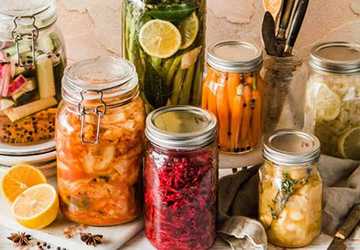How to Ferment Vegetables at Home
Fermenting vegetables at home is a beautiful way to preserve food, enhance flavours, and boost the nutritional value. It's a process that has been around for centuries, involving the natural fermentation of vegetables using beneficial bacteria. This guide will walk you through the steps to ferment vegetables at home, from the basics to more detailed tips for success.

Understanding Fermentation
Fermentation is a natural process where microorganisms like bacteria and yeast convert sugars into acids, gases, or alcohol. When it comes to vegetables, the most common form of fermentation is lactic acid fermentation. This process preserves the vegetables and enhances their flavours and nutritional benefits. The critical bacteria in vegetable fermentation are lactobacilli, which produce lactic acid, giving fermented vegetables a tangy taste.
Benefits of Fermenting Vegetables
Nutritional Boost: Fermented vegetables are rich in probiotics, which are beneficial for gut health. They also retain more vitamins and minerals compared to canned or cooked vegetables.
Preservation: Fermentation extends the shelf life of vegetables without refrigeration.
Enhanced Flavor: Fermentation adds complex, tangy flavours that can make vegetables more enjoyable to eat.
Economic: Fermenting vegetables at home can save money compared to buying pre-fermented products.
Essential Equipment
Before starting, gather the necessary equipment. You don't need anything fancy, just some essential kitchen tools:
Vegetables: Fresh, organic vegetables are ideal.
Salt: Non-iodized salt is best for fermentation.
Water: Use filtered or distilled water to avoid chlorine, which can inhibit fermentation.
Jars: Glass jars with lids like mason jars work well.
Weights: Fermentation weights or small glass jars to keep vegetables submerged.
Fermentation Lids: These allow gases to escape without letting air in, preventing mould.
Step-by-Step Guide to Fermenting Vegetables
Choose Your Vegetables: Start with fresh, organic vegetables. Common choices include cabbage (for sauerkraut), cucumbers (for pickles), carrots, radishes, and beets. Ensure they are free from blemishes and thoroughly washed.
Prepare the Vegetables: Cut the vegetables into uniform pieces; this ensures they ferment evenly. For example, slice cucumbers into spears or rounds, shred cabbage for sauerkraut, or julienne carrots and radishes.
Make the Brine: A basic brine consists of water and salt. The standard ratio is about 1-3 tablespoons of salt per quart of water. Dissolve the salt in water thoroughly before adding it to the vegetables. This brine will create the perfect environment for beneficial bacteria to thrive while keeping harmful bacteria at bay.
Pack the Vegetables: Place the prepared vegetables into your jars. Pack them tightly to minimize air pockets, which can cause spoilage. Leave about an inch of space at the top to allow for expansion during fermentation.
Add the Brine: Pour the brine over the vegetables, submerging them fully; this is crucial to prevent mould growth. If necessary, use fermentation weights or small glass jars to keep the vegetables submerged.
Seal the Jars: Place the fermentation lids on the jars. If you don’t have fermentation lids, you can use regular lids but open them slightly to release gases produced during fermentation.
Store and Ferment: Store the jars in a cool, dark place. The ideal ferment temperature is between 65-75°F (18-24°C). Fermentation time varies depending on the vegetable and your taste preference. Most vegetables ferment in 3-10 days, but some can take up to a month. Taste the vegetables periodically to determine when they are to your liking.
Check and Store: Transfer the jars to the refrigerator once the vegetables have reached the desired flavour and texture. Cold storage slows down fermentation and helps preserve the vegetables for several months.
Tips for Successful Fermentation
Use Fresh Ingredients: Fresh, high-quality vegetables and salt are essential to successful fermentation.
Maintain Proper Temperature: Keep the fermenting jars in a cool, dark place to avoid overheating, which can spoil the batch.

Avoid Contamination: Ensure all equipment and vegetables are clean to prevent unwanted bacteria or mould.
Monitor Daily: Check the fermenting jars daily for signs of mould or scum. If you see any, remove it immediately.
Experiment: Try different vegetables, spices, and herbs to create unique flavours.
Common Fermentation Issues
Mold: Mold can sometimes form on the surface of the vegetables. This usually happens when they are not fully submerged in the brine. If you see mould, remove it immediately and ensure the vegetables are submerged. If mould persists, starting with a new batch might be best.
Slimy Vegetables: Slimy texture can result from temperature conditions that are too high during fermentation. Ensure you keep the jars in a cool, dark place and use the correct salt-to-water ratio in the brine.
Off Smells: Fermented vegetables should have a pleasant, tangy smell. If they smell rotten or overly foul, it's best to discard them. This can happen if the vegetables are not fresh or there is contamination.
Popular Fermented Vegetable Recipes
Sauerkraut
Ingredients: Cabbage, salt.
Instructions: Shred cabbage, mix with salt, and pack tightly into jars. Ferment for 1-4 weeks.
Kimchi
Ingredients: Napa cabbage, radishes, carrots, garlic, ginger, chilli flakes, salt.
Instructions: Chop vegetables, mix with salt and spices, and pack tightly into jars. Ferment for 1-2 weeks.
Pickles
Ingredients: Cucumbers, garlic, dill, salt, water.
Instructions: Slice cucumbers, place in jars with garlic and dill, and add brine. Ferment for 1-2 weeks.
Troubleshooting and Enhancing Your Fermentation Experience
Preventing Mold
One common challenge in vegetable fermentation is preventing mould. Using fermentation lids that allow gases to escape without letting air in can help. Also, ensure your vegetables are permanently fully submerged in the brine. A trick is using a cabbage leaf on top of your vegetables as a barrier, which can help submerge everything.
Enhancing Flavor
To boost the flavour of your fermented vegetables, consider adding spices, herbs, or even fruit. For example, adding garlic, dill, and peppercorns to cucumbers can make delicious pickles. Experiment with different combinations to find what you enjoy the most.
Monitoring Fermentation Progress
Keep a close eye on your fermenting vegetables. Bubbles and a slight tangy smell are promising signs of active fermentation. If the brine level drops, top it up with a little more salt water. Patience is vital; letting your vegetables ferment longer can deepen the flavours.
Conclusion
Fermenting vegetables at home is a rewarding process that preserves food and enhances its nutritional value and flavour. You can create delicious, healthy, fermented vegetables in your kitchen with some essential equipment and patience. Starting with simple recipes like sauerkraut or pickles allows you to build confidence in the process.
As you become more comfortable, you can experiment with different vegetables and flavours to suit your taste. This guide provides a comprehensive overview of fermentation, ensuring you have all the information to ferment vegetables successfully. Happy fermenting!





